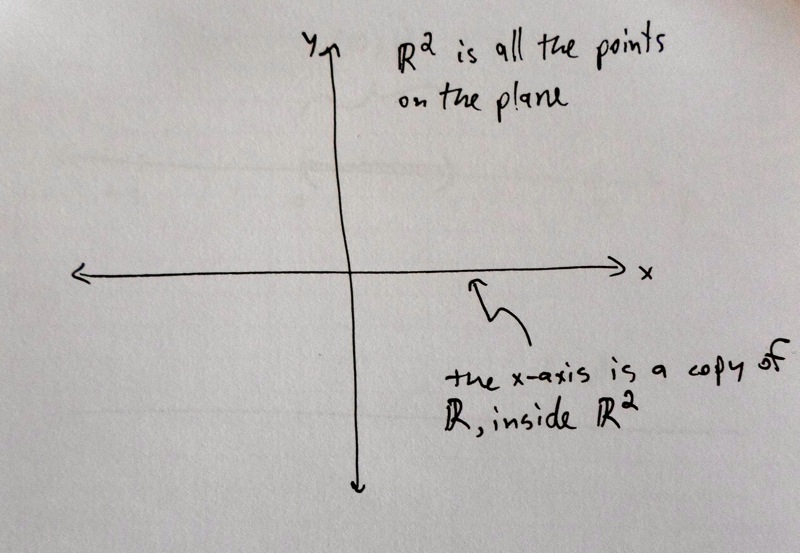Our first step towards showing \(|\mathbb{R}^2| = |\mathbb{R}|\) will be to put \(\mathbb{R}\) into one-to-one correspondence with a subset of \(\mathbb{R}^2\). Remember that \(\mathbb{R}\) is the continuous one-dimensional real line, and \(\mathbb{R}^2\) is the continuous two-dimensional plane.
We can imagine a copy of \(\mathbb{R}\) sitting inside \(\mathbb{R}^2\), as the \(x\)-axis of a coordinate system. The elements of \(\mathbb{R}^2\) are of the form \([x, y]\), where \(x\) and \(y\) are real numbers. Then the \(x\)-axis is all the points of the form \([x, 0]\), where \(x\) is any real number. (The \(x\)-axis is exactly the points where the \(y\)-coordinate is zero.)

So we can construct a one-to-one correspondence between \(\mathbb{R}\) and the \(x\)-axis of the plane. Every real number \(x\) gets assigned to \([x, 0]\). This clearly hits every point on the \(x\)-axis once and only once. Since the \(x\)-axis is a subset of the whole plane \(\mathbb{R}^2\), we can use the Cantor-Bernstein-Schroeder theorem to conclude that \(|\mathbb{R}| ≤ |\mathbb{R}^2|\).
If we naively took each point \([x,y]\) and assigned it to the real number created by interweaving the digits of \(x\) and \(y\), as discussed in the short explanation, then we get into trouble. The same point \([1, 4]\) would get assigned to four different real numbers, depending on which representation we chose!
\[14\\ 04.9090909090…\\ 13.0909090909…\\ 03.9999999….\]
These are all very different real numbers.
But we still have one problem: not every real number gets hit by the assignment rule. For example, consider the real number
\[04.90909090…\]
If we unweave this real number, we get
\[[0.999999… , 4.00000].\]
But this is the same as \([1, 4]\), and according to our assignment rule this goes to \(14\). In other words, there is no element \([x,y]\) of \(\mathbb{R}^2\) that gets assigned to \(4.909090…\).
Fortunately this isn't a big problem. What we have shown is that there is a one-to-one correspondence between \(\mathbb{R}^2\) and a subset of \(\mathbb{R}\) (the subset of real numbers that do get hit by our assignment rule). Using the Cantor-Bernstein-Schroeder theorem we mentioned above, this is enough to conclude that \(|\mathbb{R}^2| ≤ |\mathbb{R}|\). And since we already showed that \(|\mathbb{R}| ≤ |\mathbb{R}^2|\), we have proved that \(|\mathbb{R}^2| = |\mathbb{R}|\).
